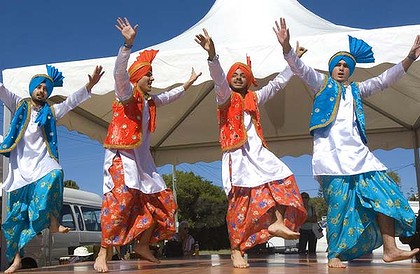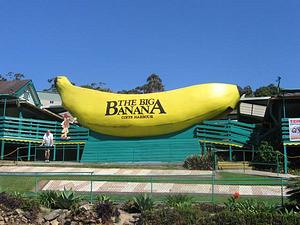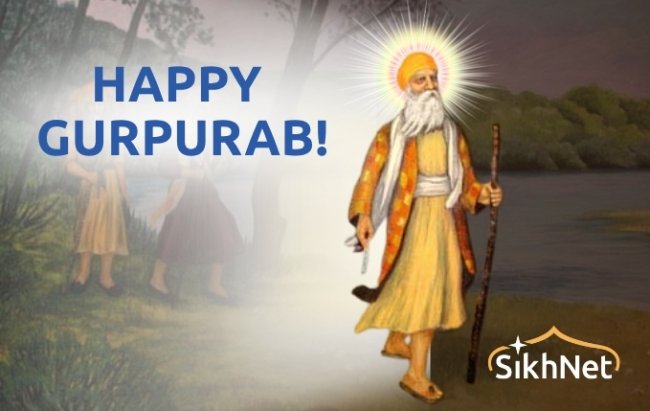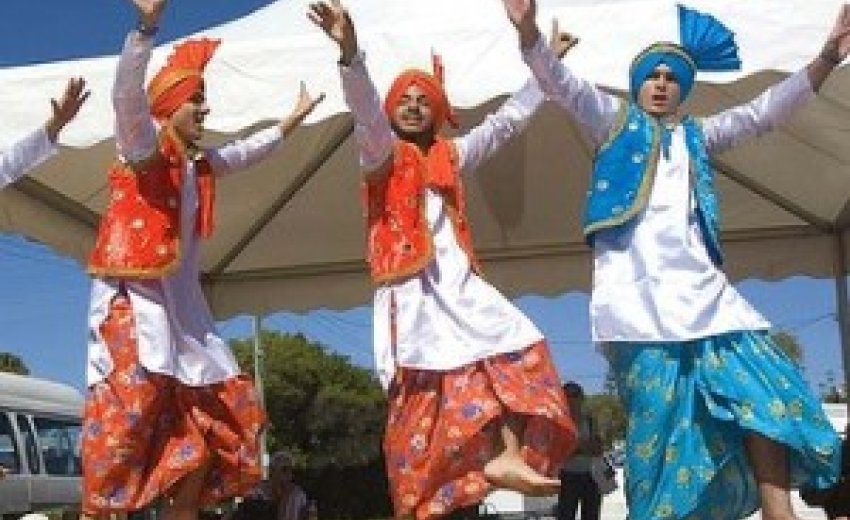 |
| Footloose ... a swirl of colour by Sikh dancers at Woolgoolga. Photo: Rob Cleary |
Daniel Scott journeys to a Sikh temple in Woolgoolga and unravels some of life's mysteries.
Oct 30, 2010: I've always been intrigued, as we've driven past Woolgoolga on journeys north, by the ornate white edifice with domes and minarets crowning a hill above the Pacific Highway. The Guru Nanak Temple, opened in 1970, is the most visible sign of Australia's largest regional Sikh population, a thriving pocket of India in the land of the Big Banana, 20 kilometres north of Coffs Harbour.
As a callow teenager, I learnt to travel in India on an epic 25,000-kilometre journey across the subcontinent. But I never visited the Punjab region, where Sikhism originates, so the religion of turbanned, big-bearded men has remained a mystery to me.
This morning, the second of a two-day family visit to Woolgoolga, I've finally made it to the temple and the mystery is unravelling.
"Sikhism is very close to Buddhism and the Baha'i faith," says a prominent Sikh on Coffs City Council, John Arkan, who is showing a small group around the temple.
"We have no caste system, no priest," he continues, as we remove our shoes and cover our heads with bandannas before entering the temple, "and the guru instilled the idea of equality between men and women."
Founded by Guru Nanak in the 15th century and based on his teachings and those of 10 subsequent gurus, Sikhism is the world's fifth-largest organised religion. In Woolgoolga, 300 families worship at the gurdwara (temple) and there are plans to build another nearby.
We make our way upstairs and into a large open room, at the centre of which is a palki, an altar upon which the scriptures are placed each day. It's a welcoming, colorful space but not over-elaborate.
We sit cross-legged and Arkan explains more about his faith. "We don't cut our hair because nature created it that way," he says, "so we normally wrap it in a turban together with a wooden comb to keep it clean." The uncut hair (kesh) and comb (kanga) are two of the five "Ks" worn by baptised Sikhs; the others are circular bangles (kara), symbolising God's eternity; a small double-edged sword (kirpan), representing day and night; and undershorts (kachera).
Later, after Arkan shows us the cubby hole in which the guru's scriptures are "put to bed" each night, we head downstairs, where a group of smiling women is preparing vegetarian food.
"You can visit any of our temples and there's always a vegetarian meal available," Jaswinder Kaur tells us, pouring cups of chai. "The sharing of food is part of our religion. There is food cooking constantly at our Golden Temple in Amritsar."
 It's hard to leave but Arkan has promised to take us to the banana and blueberry plantations that cling to the steeply sloping hills behind Woolgoolga. Ninety per cent of the farms here, where bananas are being gradually replaced by more profitable blueberries, are owned by Sikhs.
It's hard to leave but Arkan has promised to take us to the banana and blueberry plantations that cling to the steeply sloping hills behind Woolgoolga. Ninety per cent of the farms here, where bananas are being gradually replaced by more profitable blueberries, are owned by Sikhs.
After climbing a series of alarmingly rutted tracks between crops, we mount a ridge and find ourselves in a grassy clearing. We survey hectares of green plantations and on this clear, sunny day there are views to the Solitary Islands offshore. Beneath us, wrapped around a big beach beside a winding creek, is "the missing piece of paradise" or "Woopi", as the locals call Woolgoolga.
"No, Woopi doesn't mean anything," giggles Glenys, of the town's tourist information centre, when I inquire about the nickname. "I think somebody thought it was funny, something about making whoopee in Woolgoolga."
The region around the town was originally inhabited by the Gumbaingirr tribe and the name Woolgoolga, officially adopted in 1966, is said to derive from their word for the lilly-pilly tree. Settlers arrived here at the end of the 19th century and founded the timber industry. By the 1930s, banana farming was taking off; although there had been Sikhs living in the area for some time, many settled here to farm the fruit in the '40s. Sikh migrants later acquired leaseholds and freeholds on banana plantations, often collectively, and Punjabi wives began joining their now-established husbands.
"How hot do you want it?" Mick Hundal asks me later that day at his Spice Rack restaurant, where we're hoping to find an authentic Punjabi curry. "Hot or hot, hot?"
Hundal arrived in Australia from Amritsar in 1967 to work as a sugar-cane labourer in Queensland, before moving south. He's also, like many older Sikh men we've met, an absolute sook for a baby. After creating a delicious spicy feast, he cradles our nine-month-old Freya, while she tugs on his white beard during our meal.
During our visit we're staying at the spacious Safety Beach Ocean Bungalows, run by Kelvin and Collette Harris, and Kiwi Kelvin, in particular, is a proud ambassador for his area.
On our first afternoon Kelvin takes us into Woolgoolga's hinterland to Sherwood Nature Reserve, where we follow a track that criss-crosses Woolgoolga Creek to a waterfall. It's a lovely 3½-kilometre walk through a rainforest of strangler figs, extravagant elkhorns and strands of hoop pine. The bird life, from yellow-throated wrens to wompoo pigeons, is varied, too.
Returning to the bungalows, we're bundled into a golf buggy and taken for a ride on the adjacent course. There are mobs of kangaroo, 30 or 40 strong, on every fairway.
Early the next morning Kelvin has arranged for me to join Coffs-based Precision Helicopters for a scenic flight over the coast. It's a thrilling ride - above Woolgoolga's chunky headland, one of the coast's optimum whale-watching spots, then swooping over a succession of unspoilt beaches stretching north. The highlight comes when we circle above the Guru Nanak temple, gleaming Taj Mahal-like in the sunshine.
Kelvin's unofficial tour continues the next day when he shows us the assorted pleasures of Woolgoolga's northern beaches, including Mullaway, Mullawarra and Arrawarra, with its old Aboriginal fish trap in one corner. It concludes in the pleasant town centre, where we discover that the culinary scene is not all about curry, with an excellent outdoor lunch at the sophisticated Bluebottles Brasserie.
In the end, though, it is Woolgoolga's welcoming Sikhs who give the town its distinctive character and it's people such as John Arkan and Mick Hundal who have made our visit to this little piece of India on the mid-north coast so memorable.
MASTER'S TIPS LIFT THE LID ON PUNJABI TREATS
DURING our visit to Woolgoolga we are left in no doubt about how central food is to the vibrant Sikh community. At the temple, preparations are under way for a three-day scripture reading. In the kitchen sit industrial-sized vats of fresh ginger, and delectable aromas are already rising from huge pots bubbling away on stove tops.
At Spice Rack, a restaurant near the Guru Nanak Temple, we have the best palak paneer curry we've tasted outside India. Afterwards, restaurateur Mick Hundal leads us into the kitchen to share the secret of how this dish, integral to Punjabi cooking, is made.
"The principal ingredients are the fresh spinach or palak and our home-made cheese, or paneer," he says.
"The paneer I pre-prepare in bulk and keep in the fridge. To make it, I boil up three litres of milk and then add two tablespoons of vinegar." Solid curds separate from the liquid and should be allowed to cool a little. While still warm they are strained through a gauze, then wrapped up in it and tied.
"Finally," Hundal says, "I place a cutting board on top and a heavy weight on that — I use a carton of beer — to flatten it. Then leave it for two hours and cut up as much as you need."
For four people Hundal uses two bunches of spinach, boiled for six minutes with a little bicarbonate of soda, then drained and pureed.
"Now," Hundal says, firing a burner, "you fry up some finely chopped garlic, then some onion in canola oil, add a little salt and when they are lightly browned, two chopped, medium-sized tomatoes." Next Hundal adds his own garam masala. Typically he uses one teaspoon each of ground cumin, coriander, turmeric and minced ginger.
The blended spinach is added to this aromatic dish, then some finely chopped green chilli. Finally, Hundal adds a few handfuls of his carefully crafted paneer.
"Cook the cheese for about two minutes and that's it," Hundal beams, "the perfect palak paneer in under 10 minutes."
Each year, Woolgoolga celebrates its association with spicy food during Curryfest, which takes place in tandem with Sikh Baisakhi Festival and attracts more than 10,000 visitors. Next year's Curryfest is on Saturday, April 9, and will be bigger than ever.
See curryfest.com.au.
Daniel Scott stayed courtesy of Safety Beach Ocean Bungalows.
Related Story: Going Bananas in Woolgoolga

